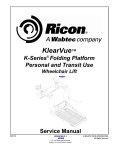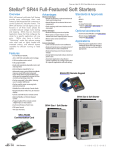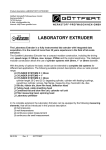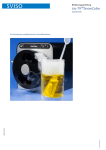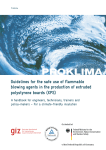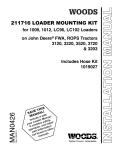Download ColdJet AeRO 75 Specifications
Transcript
Operator Manual AeRO 75 Series Voltage: 100-130 Volts AC Model No.: AeRO 75 Model No.: AeRO 75-DX Control No./ 2A0148-G1 Diagram: Control No./ 2A0148-G2 Diagram: Voltage: 200-240 Volts AC Model No.: AeRO 75 Control No./ 2A0148-G1 Diagram: Voltage: 100-130 Volts AC Voltage: 200-240 Volts AC Model No.: AeRO 75-DX Control No./ 2A0148-G2 Diagram: This manual illustrates the safety, operation, and maintenance features of the Cold Jet AeRO 75 Series. The build and revision level is located on the machine’s data plate. All Machine diagrams are located on the inside of the electrical cover plate. The design contained in this manual was originated by and is the exclusive property of Cold Jet, LLC. It is not to be used in any way detrimental to the interests of Cold Jet, LLC. No part of this design or manual may be reproduced, transmitted, stored in a retrieval system, or translated into any other language or computer language, in whole or in part, in any form or by any means, whether electronic, mechanical, magnetic, optical, manual or other, without the express written consent of Cold Jet, LLC. Special Notes All information contained within this manual, or information derived from exposure to the technology or equipment supplied by Cold Jet, LLC remains “CONFIDENTIAL” between Cold Jet, LLC and the purchaser or authorized user. Any unauthorized transfer of information to any person or company not in the direct employ of Cold Jet, LLC, or not in the direct employ of the purchaser or the authorized user, is strictly prohibited. Copyright 2007 by Cold Jet All Rights Reserved Printed in U.S.A. P/N: 2W0245-C Table of Contents Safety General Safety Precautions....................................................................6 Electrostatic Discharge...........................................................................7 Carbon Dioxide......................................................................................8 Blast Hose Safety Precautions...............................................................9 Finger Guard Precautions.......................................................................10 Component Guide Introducing the Cold Jet AeRO 75 & AeRO 75-DX.................................15 Front View..............................................................................................16 Back View..............................................................................................18 Control Panel.........................................................................................20 Hopper...................................................................................................21 Regulator Configuration..........................................................................25 Coalescing/Particulate Air Filter.............................................................27 Blast Applicator......................................................................................28 Operation Starting Up.............................................................................................32 Blasting..................................................................................................34 Shutting Down.......................................................................................35 Maintenance Troubleshooting......................................................................................38 Daily/Weekly Maintenance.....................................................................39 Monthly/Biannual Maintenance..............................................................41 Appendix Specifications.........................................................................................44 Tips........................................................................................................45 Blast Air Quality......................................................................................46 Cold Jet Services...................................................................................48 Machine Symbols...................................................................................49 Warranty................................................................................................51 Safety Safety General Safety Precautions • • • • • • • • • • • • • • • • • • • • • • • • NEVER OPERATE the unit without first reading the Operator Manual. NEVER EXPOSE bare skin to CO2 ice. ALWAYS WEAR safety glasses, gloves, 32+NRR ear plugs & ear muffs. EVERYONE in the blast area must comply with all safety requirements. NEVER POINT the nozzle at anyone and ALWAYS exercise extreme caution when people are in the blast area. NEVER use a wire tie to hold the applicator trigger in the ON position. Doing so can damage it and void its warranty. NEVER USE the blasting unit for anything except the intended usage. ONLY USE dry ice pellets as the blasting media. NEVER OPERATE in a confined space without an approved ventilation system and a carbon dioxide monitoring device is recommended. NEVER mask the ventilation holes. NEVER ALLOW UNTRAINED PERSONNEL to operate the blasting unit. NEVER OPERATE a damaged blasting unit. ALWAYS turn the main power OFF and remove the applicator control cable before removing the blast hose. NEVER exceed recommended hose or blasting unit pressure levels. ALWAYS ground the material being cleaned. ALWAYS ENSURE that hoses are securely attached. KEEP hoses and power cord out of forklift traffic areas. CHECK hoses and cables for nicks and gouges. Do NOT kink the blast hose before or during operation. NEVER DISCONNECT the air supply hose without first shutting off the source air. ONLY COLD JET TRAINED service technicians are allowed to work on the unit’s electrical components. Do not operate equipment with electrical parts exposed, jumpered or rendered inoperable. ALWAYS Follow the guidelines of the governing codes of your local/national body as a minimum standard for ensuring safety. Please refer to Carbon Dioxide (CO2) MSDS sheet for all safety precautions. (MSDS sheet available upon request.) Electrostatic discharge can be hazardous to the operator and the equipment. The static charge of CO2 varies with the amount of ice and humidity present. Follow these instructions to assure safe operation while blasting. Safety Electrostatic Discharge Safety Precautions A) The power outlet must have a good ground This is critical for electrostatic dissipation. If the ground is not connected a charge will build up on the unit or the applicator. As a secondary backup the unit's electrically conductive wheels will help bleed off any additional static charge. B) The blasting unit’s static ground cable must be attached to the target surface If a target is on a non-grounded surface it will build up an electrostatic charge, which could injure the operator or damage the equipment. Wrap or clip the static ground cable to the target to dissipate the charge. Metal framing, that holds the target in place, can be used but the target and frame must be electrically connected. Use a conductivity tester for confirmation. C) Know your environment Electrostatic buildup changes as humidity levels change and will vary by location. Electrostatic discharge is higher at low humidity levels and occurs most often during cold weather. Safety Carbon Dioxide Safety Precautions Carbon Dioxide (CO2) is a naturally occurring gas and a normal by-product of breathing. However caution MUST be exercised! • This unit utilizes Carbon Dioxide (Dry Ice) as a blast media. • Dry Ice is very cold -110°F (-79°C) and may freeze skin instantly. • CO2 is a heavy gas, which means it will settle to the ground. • Always ventilate when blasting. • When blasting in a confined space, use of a Carbon Dioxide monitoring device is recommended. • CO2 is nontoxic, non-corrosive, non-conductive and is approved by the FDA and USDA. While exposure to CO2 gas is not harmful in low concentrations, CAUTION must be exercised when using any material that can DISPLACE OXYGEN. WARNING This product utilizes Carbon Dioxide (CO2) as a blast media, EXTREMELY COLD, CAUSES SEVERE BURNS. CO2 can freeze the skin instantly. Always use protective clothing (Thermal Gloves) and eye protection when handling CO2 solids or when using the blasting unit. WARNING INCREASED LEVELS OF CO2 WHEN BLASTING IN A CONFINED SPACE CAN DISPLACE BREATHABLE OXYGEN CREATING A RISK OF SERIOUS INJURY OR DEATH BY SUFFOCATION, THEREFORE USE OF A CARBON DIOXIDE MONITORING DEVICE IS RECOMMENDED WHEN USING IN A CONFINED SPACE. • • ALWAYS tighten hose fittings with a wrench. Safety Blast Hose Safety Precautions NEVER USE hoses above the recommended working pressure. (see table) Part Number Description Working Pressure Machine 2N0177 3/4" Urebrade Hose 140 psi (9.65 bar) AeRO 75 AeRO 75-DX (Low Pressure) 2N0178 1" Urebrade Hose 140 psi (9.65 bar) AeRO 75 2N0179 1-1/4" Urebrade Hose 140 psi (9.65 bar) AeRO 75 AeRO 75-DX (Low Pressure) 2N0180 1" Kevlar Hose 300 psi (20 bar) AeRO 75-DX (High Pressure) 2N0181 1-1/4" Kevlar Hose 300 psi (20 bar) AeRO 75-DX (High Pressure) • NEVER DISCONNECT the supply air hose without first shutting off the source air. • • BLEED the compressed air before disconnecting the hoses. NEVER OPERATE the equipment if the hose whip check is not installed. Safety Finger Guard Precautions Finger Guard The finger guard on the Cold Jet AeRO 75 series protects from a potential personal injury site located inside the machine. The guard, over the air exhaust port, must remain installed at all times to serve its function. 10 • For optimal performance it is recommended that the air supply dew point be -40oF (-40oC) or lower. • For optimal performance make sure the air is clean and free from oil and grit. • If needed, use an after-cooler and an air dryer with air filtration, to obtain desired air quality and dew point (air drying and filtration equipment may be purchased from Cold Jet). • If you intend to provide your own air drying and filtration equipment, consult Cold Jet Customer Support for assistance in selecting the correct models. • The length of blast time at higher dew points depends on relative humidity, temperature and excessive condensation in the hopper and on the pellets. • At EVERY blasting start-up ALWAYS purge the Cold Jet AeRO 75 & 75-DX with compressed air before adding pellets to the hopper. • ALWAYS shut the fill lid to avoid foreign objects falling in. • ALWAYS avoid bad ice. Safety Before You Begin IMPORTANT ALWAYS MAKE SURE THE HOPPER IS EMPTY AND BLAST WITH AIR ONLY, FOR 1 MIN. WHEN SHUTTING DOWN LONGER THAN 15 MIN. FAILURE TO DO SO MAY RESULT IN FEEDER AND/OR NOZZLE FREEZE-UP. 11 12 Component Guide 13 14 • The Cold Jet AeRO 75 & 75-DX are portable units providing easy access for difficult to reach cleaning applications. • The Cold Jet AeRO 75 & 75-DX use dry ice pellets from either an onsite pelletizer or shipped in from a distribution center. • The blast machine requires a source of compressed air and standard electrical power for operation. • The blast machine contains an innovative, patented feeder and control system to maintain consistent pellet flow. • During operation the feeder transfers the pellets from the hopper to a stream of compressed air at a rate determined by the feed control system. • After exiting the nozzle and striking the surface, the CO2 pellets sublimate into the atmosphere. • The only residue left behind is the blasted contaminant. • The Cold Jet AeRO 75 & 75-DX have the capacity to hold 75 lbs (34 kg) of CO2 pellets. • The delivery is variable from 0 - 7 lbs/min (0 - 3.2 kg/min). • The Cold Jet AeRO 75 can blast from 30 - 140 psi (2 - 9.66 bar) and the AeRO 75-DX can blast from 30 - 300 psi (2 - 20 bar). Below 60 psi (4 bar) a regulator is required. Component Guide Introducing the AeRO 75 & AeRO 75-DX 15 Component Guide AeRO 75 Front View Control Panel Nozzle Hangers Electrical Enclosure (SERVICE ONLY) Static Ground Cable 16 Blast Cable Connector Blast Hose Connector Fork-Lift Tubes Control Panel Nozzle Hangers Electrical Enclosure (SERVICE ONLY) Static Ground Cable Blast Cable Connector Blast Hose Connector Component Guide AeRO 75-DX Front View Fork-Lift Tubes 17 Component Guide AeRO 75 Back View Hose Hangers Power Cord Hanger AC Power Cord Bleed Valve 18 Whip Check Air Supply Hose Connect Component Guide AeRO 75-DX Back View Hopper Release Handle Hose Hangers Power Cord Hanger AC Power Cord Bleed Valve Whip Check Air Supply Hose Connect 19 Component Guide Control Panel Power Switch Power Indicator Feed Rate Hour Meter Machine Active light - When light is on machine is ready to blast (the hopper access door being open is an example of the light being off). 20 E-Stop Pressure Gauge Component Guide Hopper Hopper Access Door - Used for accessing hopper for ice or debris removal. Unit will not operate when door is open. 21 Component Guide Slide Out Hopper (AeRO 75-DX Only) 1. Rotate release handle counter-clockwise. 2. Slide out hopper. 22 Fill Lid. Used for adding ice. Metal Grate Prevents large debris from entering the hopper. Component Guide Top 23 Component Guide Inside (Standard Configuration) Hopper Assembly Includes two Vibrators and a Pneumatic Thumper. Safety Switch Disables the system when the door is open. Airflow Actuator & Blast Valve Air Filter Feeder 24 (Pneumatic Controls) Regulator (Pneumatic Controls) Control Valves Air Pressure Knob - Used to set the blast air pressure to the desired value by turning the knob prior to blasting. Component Guide Inside (Optional Regulator Configuration) Optional Inline Pressure Regulator Used for precise blast air pressure control. 25 26 Differential pressure gauge - Indicates if the filter needs changing. Component Guide Optional (Coalescing/Particulate Air Filter) Air Filter - Used to extract moisture and dirt from the supply air. Drain Valve - Used to drain excess water. 27 Component Guide Single Feed Blast Applicator (AeRO 75 Only) Blast Cable Connector JICM Connector Rotation Stop Protects blast cable from damage Retention Collar Trigger Also breaks up ice if pressed rapidly Safety Switch Safety ON 28 Safety OFF (AeRO 75-DX Only) Blast Cable Connector JICM Connector Rotation Stop Protects blast cable from damage Retention Collar Component Guide Tri-Mode Blast Applicator Trigger Also breaks up ice if pressed rapidly Safety Switch Tri-Mode Speed Control Up - Sets speed to 2/3 of Max Middle - User Set Speed Down - Purge (removes nozzle clogs) Safety ON Safety OFF 29 30 Operation 31 Operation Starting Up 1 Make sure the Power Switch and bleed valve are in the OFF (O) position. 2 Attach the blast hose and the control cable to the machine. 3 Securely attach the applicator to the blast hose and control cable. Make sure the Rotation Stop is facing UP. Verify that a nozzle is locked into the Blast Applicator. 4 Attach the whip-check to the air supply hose and extend it as far as possible on the air hose. 32 Attach the Air Supply Hose to the inlet air pipe on the back of the machine. (Check the data plate for the operating pressure range). Operation 5 Make sure the hopper is dry, clean, and free of debris. 6 Connect the Static Ground Cable to the material to be cleaned or to an electrically conductive supporting structure of the material. 7 Turn on the air compressor, and allow the air supply hose to pressurize. Check for leaks. 8 Plug the power cord into an electrical outlet. If an extension cord is necessary, it must comply with the power requirements of this unit and all governing electrical codes (Check the data plate for the operating voltage range). 9 Turn the Power Switch to the ON (I) position. 10 Turn the Bleed Valve ON (I) to drain water out of the filter, then turn it OFF (O) to close it. 33 Operation Blasting 1 Push the Applicator Safety Switch forward. 2 Purge the system by blasting with air for 1 min. How to Purge: Before loading the pellets into the hopper, turn the feed control to its maximum setting and pull the trigger. After purging, return the feed control to the desired blast setting. 3 Pour the pellets into the hopper. IMPORTANT 4 Close the Fill Lid. Pressing and Releasing the Applicator Trigger makes the thumper break up any ice clumps. IMPORTANT LETTING THE SYSTEM RUN UNTIL IT EMPTIES KEEPS THE UNIT IN IDEAL CONDITION. 5 Squeeze the Applicator trigger to blast. If desired push the speed switch up to increase the feed rate to clean tough spots (AeRO 75-DX ONLY). 34 1 Stop blasting and push the safety switch back. (This activates the safety). Operation Shutting Down 2 For the AeRO 75 slide open the hopper access door and scoop out the remaining dry ice from the hopper. For the AeRO 75DX, just slide the hopper out to empty any remaining ice. 3 Turn OFF the compressed air supply. 4 Turn the power switch OFF (O) to shut off the power. 5 Turn the Bleed Valve ON (I) to evacuate all remaining pressure. 6 If open, close the Fill Lid. 7 When the air hose is fully depressurized, disconnect all electric cables, then the hoses, and wrap them around the hose hangers. 35 36 Maintenance 37 Maintenance Troubleshooting Problem Machine will not start GREEN light is not on Machine will not blast Check This Solution Is the unit plugged in? If NO...Plug Unit in. Is the power switch in the ON (I) position? If NO...Push power switch to I. It still will not start up? Call Cold Jet for support. Is the machine active light (the BLUE light) on? If NO... Close the hopper access door and reset the Estop. Also make sure the slide-out hopper is latched closed (DX only). If the above doesn't work then check fuses FU1 & FU2 Is the applicator safety switch pushed back? If YES...Flip the switch forward. Is the optional Coalescing Filter gauge redlining? If YES...Immediately replace the filter element. Is the air supply connected and the air supply on? Is the air supply gauge showing pressure? Is the optional pressure regulator open and displaying pressure? If YES...The nozzle may be clogged, blast with air only to unclog it. Is applicator cable connected to the machine and the applicator? Machine blasts AIR but NOT pellets Set feeder speed and check the thumper for movement. If no movement see below. Do Vibrator fuses FU3 and FU4 glow orange? If YES...Replace the fuse(s) that glows orange. The Hopper may be clogged. Squeeze the trigger to break up ice clumps. A foreign object may be lodged in the feeder. Call Cold Jet for support. For additional help contact our Customer Support hotline: +1-800-777-9101 (+1-513-576-8981) 38 Make sure the gauge is in the GREEN. If not then change the filter element to avoid damage to the machine Maintenance Daily Maintenance Drain the water out of the optional Coalescing filter by opening the drain valve at the bottom of the filter. Drain water out of the air filter before using the machine. (Turn the bleed valve ON (I) to drain the water). While in operation check the pressure gauge for damage. Check the air and blast hoses for damage, like cuts or scuff marks. 39 Maintenance Weekly Maintenance Look through the hopper to check the rotor for nicks or gouges. (Use a flashlight). Make sure the nozzle airflow exit end is not deformed or burred. 40 Maintenance Monthly Maintenance Check the thumper for worn or damaged parts and also check for loose fittings. Check the Vibrators for vibration. Also check the two mounting bolts, on each vibrator, to verify they are secure. Check the Air Filter by unscrewing the base a 1/4 turn clockwise. 41 Maintenance Biannual Maintenance If you are not an authorized Cold Jet Service Technician, please call to schedule service. +1-800-777-9101 or +1-513-576-8981 or email: [email protected] (Europe: 32 (0) 13 53 94 47, Office Hours: GMT +1.00 or email: [email protected]) 1 Check pads and rotor 2 Check pneumatic air lines 3 Check thumper and vibrator assemblies 4 Check condition of power cord 5 Check all lights 6 Check the pressure gauge 7 Check static ground cable 8 Inspect hoses for damage 9 Replace the air filter element 10 Check the accessories 11 Safety test the unit 12 Check all valves 42 Appendix 43 Appendix Specifications AeRO 75 AeRO 75-DX Weight (empty): 295 lbs. (134 kg.) 315 lbs. (143 kg.) Pellet Capacity: 75 lbs. (34 kg.) 75 lbs. (34 kg.) Pellet Delivery Rate: Variable From: 0 - 7.1 lbs/min (0 - 3.2 kg/min) Variable From: 0 - 7.1 lbs/min (0 - 3.2 kg/min) Power Requirements: 100 - 140 volts AC single phase (50/60 Hz) 9 amps or 200 - 240 volts AC single phase (50/60 Hz) 4.3 amps 100 - 140 volts AC single phase (50/60 Hz) 9 amps or 200 - 240 volts AC single phase (50/60 Hz) 4.3 amps Feeder Drive: 1/2 Hp. AC Motor 1,750 RPM 3/4 Hp. AC Motor 1,750 RPM 30 - 140 psi. (2 - 9.66 bar) 30 - 300 psi. (2 - 20 bar) Available Blast Air Pressure: 44 Appendix Tips Blasting Techniques • • • • • • • • • POSITION the blast hose for maximum maneuverability before blasting. DO NOT kink the blast hose. HOLD nozzles PERPENDICULAR to the surface for fastest cleaning (recommended for most applications). OPTIMUM STAND OFF distance is 2 in (5 cm) for most nozzles. NEVER ALLOW foreign objects to enter the hopper! DO NOT abuse the blast applicator or cable. BLAST with AIR ONLY for 1 minute after breaks (to melt any water ice build-up inside the blasting unit). SLIDE hopper access door open to empty pellets. HOPPER SHOULD BE EMPTY before refilling. Handling Pellets • • • • • • • • KEEP pellet boxes and fill lid CLOSED at all times. DO NOT use powdery or clumped pellets. USE a plastic scoop (not metal) to fill hopper. pellet-box liner fragments should not enter hopper. DO NOT BREAK the SEAL on pellet box until pellets are needed. USE pellets as soon as possible after opening the box. STORE pellet boxes out of direct sunlight. DO NOT use pellets larger than 1/8-inch (3mm) in diameter. 45 Appendix Blast Air Quality Up to 140 psi (9.6 bar) The Cold Jet AeRO 75 series blast machine works best when the supply air is free of any debris and has a dew point of -40°F (-40°C). If Using Plant Air (Central Compressed Air System) Manufacturing plants, with central compressed air systems, should have an After Cooler and a 2-stage coalescing filter assembly downstream of the receiver tank. Hot metal pipes are an indication this is needed. To verify that the plant air system is adequate for the AeRO 75 (75-DX) the air compressor needs to produce an air volume 10% greater than the blast machine's maximum air volume...in addition to the air volume consumed by normal plant operation. To determine adequate air volume, blast while watching the pressure gauge. • If the gauge drops slowly the compressor is insufficient. • If the gauge drops quickly there is a restriction or the pipe is too small. • If the gauge stays steady then the compressor and piping are adequate. To maintain adequate pressure to the AeRO 75 (75-DX): • From the air compressor to 50 ft (15 m) use a flexible 1 in (25 mm) air hose (preferably the hose supplied with the machine). • From the air compressor to beyond 50 ft (15 m) make sure the pipe is 1 in (25 mm) in diameter before attaching the air hose. If an air drop isn’t used much, water and rust will collect in the line. Before plugging into the air supply, purge the line, to prevent contamination of the AeRO 75 (75-DX). 46 Portable diesel air compressors are mainly used for shop tools, not dry ice blasting units and are therefore not able to cool or remove air moisture. An after cooler with a 15°F (-9°C) approach is required to reduce the discharge air temperature 180°F (82°C) to within 15°F (-9°C) of ambient air temperature. Appendix If Using Portable Air (minimum of 185 cfm - 5.6 m3/min) Without the after cooler, the following will occur: 1 Incoming air moisture will rapidly cool and freeze at the AeRO 75 (75DX) feeder. 2 Water ice will accumulate in the feeder, distorting the air flow and seal. 3 Water ice buildup will continue inside the blast hose, to the nozzle. 4 Water ice will break off inside the hose and lodge in the nozzle, causing a jam. 5 Water ice, may exit the nozzle, and damage the target surface. For the above reasons, an after cooler and moisture trap/filter must be used. If blasting continuously, use an air dryer to further reduce the air moisture (dew point). Desiccant dryers produce a dew point of -40°F (-40°C), resulting in a dew point low enough for continuous blasting. To verify the compressor is of adequate size for the AeRO 75 (75-DX) the air compressor needs to produce an air volume 10% greater than the blast machine's maximum permissable air volume. To determine adequate air volume, blast while watching the pressure gauge. • If the gauge drops slowly the compressor is insufficient. • If the gauge drops quickly there is a restriction or the pipe is too small. • If the gauge stays steady then the compressor is adequate. To maintain adequate pressure, the hose size from the compressor to the AeRO 75 (75-DX) needs to be 1 in (25 mm) in diameter. 47 Appendix Cold Jet Services • • • • • • • • • • • Equipment Upgrades Preventative Maintenance Repairs, and Refurbishing Training Parts and Accessories Spare Parts Kits Extended Service Plans Equipment Rental Contract Cleaning Services Engineered Solutions 24-Hour Technical Phone Support +1-800-777-9101 or 1-513-576-8981 (Europe: 32 (0) 13 53 95 47, Office Hours: GMT +1.00) Email Technical Support: [email protected] (Europe: [email protected]) Ordering Pellets • Call +1-800-SEND-ICE (+1-800-736-3423) or +1-877-437-9423 • RETURN empty ice boxes promptly after use. • Pellets are made using food grade QUALITY dry ice. • Manufacturers of dry ice are located throughout the world for the recommended manufacturer in your area call +1-800-777-9101 (Europe: 32 (0) 13 53 47) or e-mail [email protected] (Europe: [email protected]) 48 General mandatory action Off General danger Wear ear protection Skin puncture from pressurized air jet Read operator manual Standby Appendix Machine Symbols On Wear eye protection Electrical shock or electrocution Ready Read service manual Emergency stop Loud noise Wear safety gloves Applicator ready to blast Lock out in De-energized state Extreme cold Feed Unplug before opening Hand cut from impeller blade Flying debris Maintain safe pressure CO2 Variable feed CO2 only No foreign objects Hand crush from side Light on Explosive release of pressure Do not operate with guard removed Moving Parts Elapsed time display Programmable timer Hourmeter Light flashing Bleeding Clock Time switch Timer Effect or action to a reference point Piston extrusion Alternating current Effect or action away from a reference point Piston retraction Hydraulic motor Pressure High chamber pressure Rotary knife Protective Ground Reset Ground Test Point 49 50 Appendix Warranty Information Cold Jet® LLC (“CJ”) warrants its products (“Equipment”) provided under this Agreement to be free from defects in materials and workmanship for a period of 12 months, under normal use, maintenance and service as stipulated in the Operator’s Manual. CJ warrants that the equipment will be in good working order on the Date of Shipment and will conform to CJ’s official published specifications. The warranty period is 12 months for CJ manufactured Equipment. Original Equipment Manufacturers’ warranties provided by CJ on equipment purchased under this Agreement not manufactured by CJ will be passed through to the Buyer. The warranty period commences on the Date of Shipment of the Equipment. CJ’s liability is limited to repairing or replacing, at its option, any covered part of its Equipment, which CJ has determined to be defective. Said repair or replacement will be made by CJ or its authorized representative free of charge to the Buyer, except for any freight or travel expenses, during the warranty period. Any replaced part will become the property of CJ. If, after repeated efforts, CJ is unable to restore its Equipment to good working order, or to replace the defective parts as warranted, CJ may, at its discretion, replace the Equipment in its entirety. Any claim must be made to CJ, in writing, within 30 days of discovering the defect and any claim not made within that period shall be deemed waived or released, and thus denied. Warranty service provided under this Agreement does not assume uninterrupted operation of the Equipment. The suitability of the equipment for the purpose intended is not included in the warranty. This warranty shall not apply and CJ shall be neither responsible nor liable for: a)Consequential, collateral or special losses or damages; b)Equipment conditions caused by abnormal conditions of use, accident, neglect or misuse of equipment, improper storage or damages resulting during shipment as determined by CJ; c)The replacement of normal wear items, including but not limited to air, blast and whip end hoses; d)Deviation from the Equipment’s prescribed maintenance programs, replacement parts, operating instructions, specifications or other terms of sale; e)Labor charges, loss or damage resulting from improper operation, maintenance or repairs made by person(s) other than CJ or CJ-authorized service representatives; f)Improper application of the product. In no event shall CJ be liable for claims in excess of the purchase price, whether there is a breach of contract or warranty claim of negligence or negligent manufacture. THIS WARRANTY IS THE SOLE WARRANTY OF CJ AND ANY OTHER WARRANTIES, EXPRESS, IMPLIED IN LAW OR IMPLIED BY FACT, INCLUDING ANY WARRANTIES OF MERCHANTABILITY AND FITNESS FOR PARTICULAR USE, ARE HEREBY SPECIFICALLY EXCLUDED. 51 www.coldjet.com [email protected] +1-800-337-9423 +1-513-831-3211 52




















































